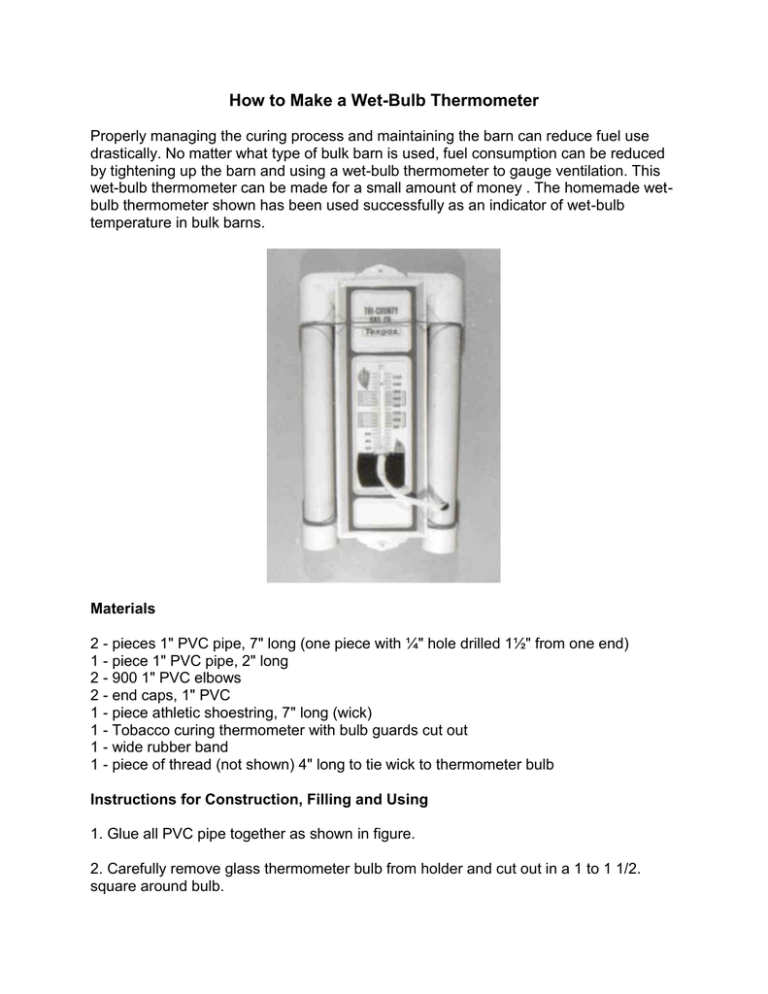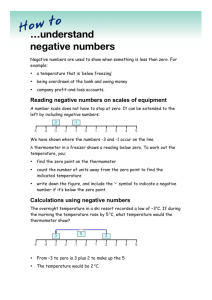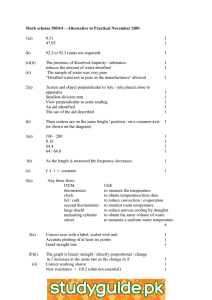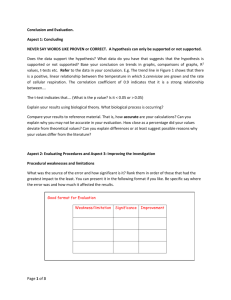How to Make a Wet-Bulb Thermometer
advertisement

How to Make a Wet-Bulb Thermometer Properly managing the curing process and maintaining the barn can reduce fuel use drastically. No matter what type of bulk barn is used, fuel consumption can be reduced by tightening up the barn and using a wet-bulb thermometer to gauge ventilation. This wet-bulb thermometer can be made for a small amount of money . The homemade wetbulb thermometer shown has been used successfully as an indicator of wet-bulb temperature in bulk barns. Materials 2 - pieces 1" PVC pipe, 7" long (one piece with ¼" hole drilled 1½" from one end) 1 - piece 1" PVC pipe, 2" long 2 - 900 1" PVC elbows 2 - end caps, 1" PVC 1 - piece athletic shoestring, 7" long (wick) 1 - Tobacco curing thermometer with bulb guards cut out 1 - wide rubber band 1 - piece of thread (not shown) 4" long to tie wick to thermometer bulb Instructions for Construction, Filling and Using 1. Glue all PVC pipe together as shown in figure. 2. Carefully remove glass thermometer bulb from holder and cut out in a 1 to 1 1/2. square around bulb. 3. Replace glass thermometer bulb and calibrate according to another thermometer. 4. Secure thermometer to PVC pipe with rubber band or light gauge wire. 5. Fill with water. Use a large syringe or a small snout "squeeze-it" type plastic detergent bottle. 6. Insert wick into water. A small nail, large toothpick, or kitchen match stick may be helpful. 7. Place in curing barn where air flow is strong. In updraft barns (e.g. Roanoke, Long, Powell) lay wet-bulb device flat on its back on the perforated floor near the loading doors. In down-draft barns (e.g. bulk tobacco), lay wet-bulb device flat on its back near the loading doors where air flow will strike the wet bulb of the thermometer. 8. Open fresh air vents only enough to maintain a wet-bulb temperature of 100o to 105o F during leaf drying and 105o to 110o F during stem drying. The University of Georgia and Ft. Valley State College, the U.S. Department of Agriculture and Counties of the state cooperating. The Cooperative Extension Service offers educational programs, assistance and materials to all people without regard to race, color, national origin, age sex or disability. An Equal Opportunity/affirmative Action Organization Committed to a Diverse Work Force. Miscellaneous Publication ENG01-003 June 2001 Issued in furtherance of Cooperative Extension work, Acts of May 8 and June 30, 1914, The University of Georgia College of Agriculture and the U. S. Department of Agriculture cooperating. Gale A. Buchanan, Dean and Director







